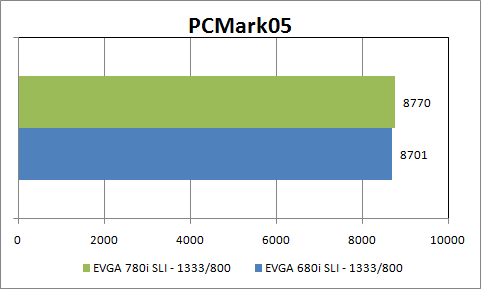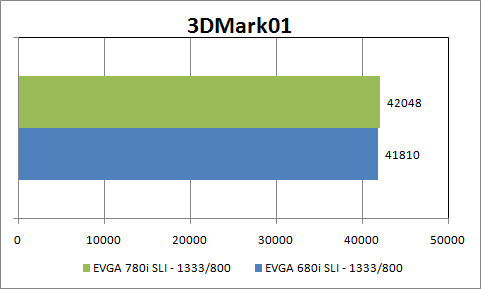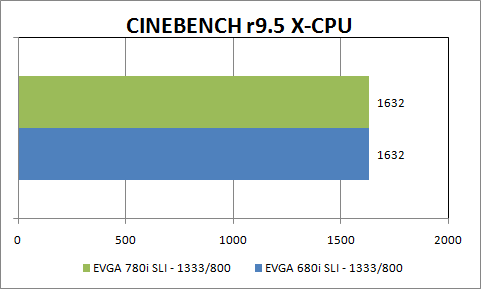NVIDIA 780i: Evolution Plus Triple SLI
by Wesley Fink on December 17, 2007 9:00 AM EST- Posted in
- CPUs
General System Performance
The PCMark05 benchmark, developed by Futuremark, is useful for determining overall system performance for the typical home computing user. This tool provides both system and component level benchmarking results utilizing subsets of real world applications or programs. The test is useful for providing comparative results across a broad array of GPU, CPU, hard disk, and memory configurations along with multithreading results. In this sense, we consider the PCMark benchmark to be both synthetic and real world in nature while providing consistency in our benchmark results.

As expected, the performance difference between 780i and 680i is less than 1%, which is well within the confidence levels of this benchmark. Essentially both chipsets perform the same.
General Graphics Performance
The 3DMark series of benchmarks from Futuremark are among the most widely used tools for benchmark reporting and comparisons. Although the benchmarks are very useful for providing apple to apple comparisons across a broad array of GPU and CPU configurations they are not a substitute for actual application and gaming benchmarks. In this sense, we consider the 3DMark benchmarks to be purely synthetic in nature but still valuable for providing consistent measurements of performance.
The later 3DMark tests, such as 3DMark05, are almost entirely influenced by the GPU under test, though CPU performance plays a larger role in 3DMark06. Results should be extremely close in this instance since we use the same graphics card for testing on both systems. 3DMark01 is still widely used because it is a useful overall system performance test. System, CPU, and memory configurations affect results far more than in later 3DMark benchmarks.


3DMark06 results are all but identical, while 3Dmark01 shows performance results within about half a percent. Performance in these general graphics benchmarks is therefore the same.
Rendering Performance
The CINEBENCH 9.5 benchmark heavily stresses the CPU subsystem while performing graphics modeling and rendering. We utilize the standard benchmark demos in each program along with the default settings. CINEBENCH 9.5 features two different benchmarks with one test utilizing a single core and the second test showcasing the power of multiple cores in rendering the benchmark image. We use the multi-core benchmark to compare the 780i and 680i.

Results in the SMP rendering tests are the same for the 680i and 780i.
Tests with these four general performance benchmarks confirm that the performance of the 780i and 680i is essentially the same when using equivalent systems. This is what we expected given the fact that NVIDIA clearly states there is no change in the micro-architecture of the 780i compared to the 680i.
Recent graphics testing has already established that current video cards do not even come close to saturating the current PCIe 1.1 bus. Future video cards and applications will be more demanding, but it will likely be some time before we see a measurable performance advantage with PCIe 2.0.










23 Comments
View All Comments
Dogbyte13 - Monday, January 7, 2008 - link
how come no 16x16 on the 750i? will there be a performance hit with 16x8?edborden - Sunday, December 30, 2007 - link
"The chipsets themselves, both 780i and 680i, are said to be perfectly capable of supporting Penryn if used on a modified board. It now appears a complete fix cannot be made with just a BIOS update for 680i; it is possible a BIOS update will allow dual-core Wolfdale to work as it should, but not quad-core Yorkfield. We will leave the official word for this with NVIDIA and their board partners."I just contacted my engineer at nVidia. He says:
"We will be releasing a BIOS to support the Penryn Wolfdale's in the
coming month, but there is no plan to support the Yorkfield quad-cores
on NF680i."
- Ed Borden, edborden.blogspot.com
edborden - Sunday, December 30, 2007 - link
nVidia had a bunch of new technologies to debut, and they wanted to do it all at the same time, with a new platform launch. Accomplishing the tech refresh on what is essentially the same chipset technology isn't necessarily a fact that has to make it non-event.I'm happy it's here - we had some significant issues with the 680i chipset and I'm hoping a re-work, some new features, and the psychological effect of a new model will help with.
Also, the XFX and eVGA partner boards (both identical, manufactured by nVidia) look ALOT better than their 680i predecessors. Better cooling, especially.
I blogged recently about us implementing these chipsets in our systems at http://edborden.blogspot.com/2007/12/nvidia-triple...">http://edborden.blogspot.com/2007/12/nvidia-triple...
kevinkreiser - Tuesday, December 18, 2007 - link
anyone know if the 780i might remedy the "display stopped responding" bug people like me are having? if so, it would be worth the upgrade.Fallen Kell - Wednesday, December 19, 2007 - link
I stopped having that problem when I changed what drivers I was using. However, since either the CPU or the motherboard is dead (don't know which because the Gigabyte board does not have a BIOS CPU test (i.e. no beep code for bad CPU), I can't tell for sure what is dead, and since I don't have another 775 CPU or 775 socket motherboard....)Anyway, I started getting the problem in August/September when I updated my drivers, but when I reverted back to previous drivers, the issue went away.
Fallen Kell - Tuesday, December 18, 2007 - link
Without support for 1600 FSB anyone who buys this is just plain stupid. Nvidia has basically released a "fixed" 680i motherboard, and in reality people like myself who purchased the original 680i and did so because they were told, "Quad CPU, 1333 FSB, Penryn Support" should all be receiving these "fixed" boards for free... Without 1600 FSB support, you will not be able to use CPU's that arrive in 3 WEEKS! If it was 3 months, maybe a different story, but 3 WEEKS!!!!! Again, anyone who buys this is an idiot and a fool.aka1nas - Wednesday, December 19, 2007 - link
You'll only be unable to run a single Extreme Edition Quad-core part without OC'ing the FSB. Regular Penryns will not be released at 1600FSB.ShantanuMalpani - Tuesday, December 18, 2007 - link
While you have conducted a test with a single 8800 GTX, im surprised that you didnt conduct a test with two of them in SLI. with both the PCIE interconnects coming from a single bridge chip, and a rumour that they allow direct communication between them using the bridge chip(like first seen on RD580), there could be an improvement in SLI performance.Alternatively the added latency of going from the northbridge to the bridge chip might cause a decrease in performance.
Also i assume that the NF200 bridge chip will be the one used in Skulltrail?
chizow - Monday, December 17, 2007 - link
Will be somewhat interested to see the OC'ing and Triple SLI results tomorrow but overall this seems a disappointing release.Honestly, it looks as if Penryn/700i is actually going to be worst for the enthusiast unless NV managed to also work out their FSB problems. If these boards can't hit higher FSB speeds than the 600-series, the higher stock FSB on Penryn (read: lower multipliers, locked upwards) will only make it harder to OC.
Also was interesting about the layout and routing of the PCI-E lanes. I must have missed the PCI-E course for dummies but it seems like this board just totally shatters the previous NB/SB model as one of the SLI cards is being routed through the SB (MCP) and 2 through an "auxiliary" (n200) chip? Will be interesting to see how this impacts performance as I was under the impression that the lanes/traces from memory controller to GPU/RAM/CPU were the main bottlenecks in current PCs and this configuration just seems to add more of them.
Frumious1 - Monday, December 17, 2007 - link
I'm not sure if the article is "meh" or it it's the boards/chipsets. I'd have liked overclocking and additional performance results, and 3Dmark as a show of performance doesn't mean much outside of the ORB weenies. How about some actual games, and how about testing SLI with a couple of 8800GT cards to see if there are any tangible benefits to PCIe 2.0? I don't really expect much, but all we got was a "this is just 680i with a new chip on the board so we're not really doing much additional testing."I don't give a rip about Tri-SLI, but Penryn support and some actual testing of whether the new PCIe specification makes a difference would have been appreciated. Maybe we can get a follow-up article that's more of a real review instead of a quick chipset overview with some motherboard pictures thrown in at the end?